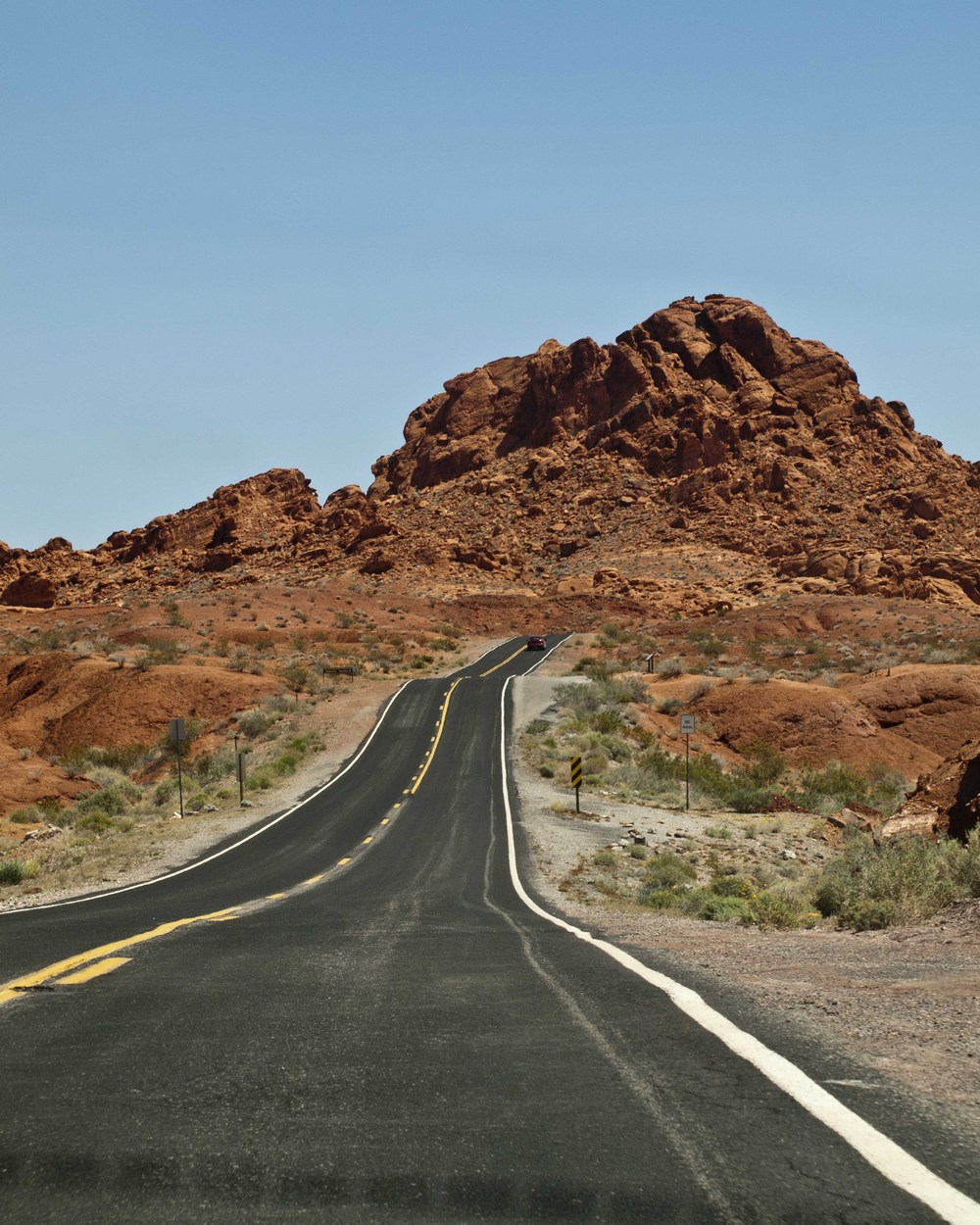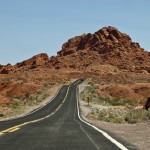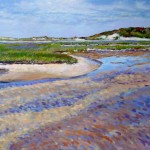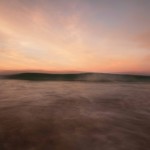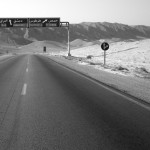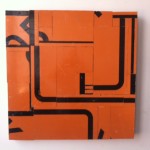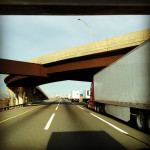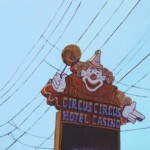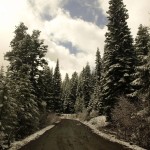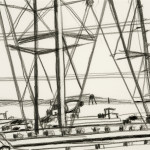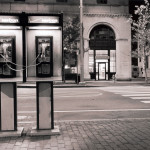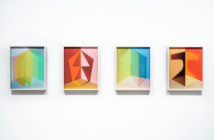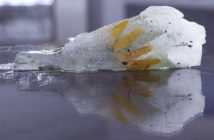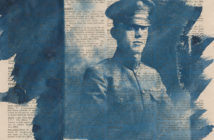The entire history of America is based on rediscovering
what has already been found. Picture yourself, late for
work, searching for your car keys and eyeglasses
only to hear the Hyundai exhaling exhaust fumes
out back in the garage. A pair of bifocals rest on top
of your hair. Now print this day inside a history book.
EXIT 2 ↗
The arc of American art doesn’t start until Eisenhower
returns from Germany horrified at our lack of preparation.
He dreams of Nazi efficiencies, supplies drawn from border
to border, tanks deployed on front lines with the ingenuity
of bowling alleys, neon signs, juke box record players laying
down tracks at the press of button-codes: V-1, V-2, A4B.He wakes from communist nightmares, sees the expanse
of countryside appropriated through violence
as indefensible without the help of landscape painting.
EXIT 3: VALLEY OF FIRE (Nevada) ↗
In the Valley of Fire everyone remembers our passion
for the line causing desert peoples to become unhinged.
First, the relentless case of rock formations had highway
workers gasping at the enterprise. No, first, the insistent
line of rifles at children’s backs, women left for dead in
tents on river sides, had people staring at the four points
of mountain peaks surrounding them, fearing the rain
would never start.

EXIT 4: OUTPOST MOTEL (Leytonville, California) ↗
With the sun-peeled sign outside announcing channels
no one cares for anymore, on the motel television you’re
reminded of the pliers your mother taught you how to
travel with. First, you were remote control, flipping
twisting wrist through indecision, but learning to leave
one thing for something else despite the broken knob.Next, you changed the lug nuts, drove away after car-in-
neutral departures down the driveway. In the future
everyone leaves their all-night movies on for the sound
of emergency response network alarms dubbed over
a perfect color chart. Arrange any set of screens showing
old westerns in their intended choreography, sets stacked
up in pyramids, and as Spencer Finch explains in West (Sunset
In My Motel Room, Monument Valley, January 26, 2007, 5:36-
6:06 PM) you have the end of days. Here, you may catch
an unwanted version of Frankenstein and know what recruiting
drunken men in black striped shirts was like, their staggering
across America, swoops and drips over land. The world can get
so desperate for a hero even thunderstorms of commercial paint
thrown down in disgust, dust mixed in with nails and glass,
convey a sort of martyrdom.(Walter de Maria’s Lightning Field changes in the light)
(You adjust the rabbit ears on any radios you own)
(Later, your dreams feature clips of Baldessari movies,
dripping colored dots on black and white)
EXIT 5: Idaho May & Island ↗
Idaho May becomes nearly impassible if you find yourself
hoping to drive by the Hemingway death house. Try to
Google map yourself out of Ketchum and the Trail Creek
Road is closed for sure. In order to trace the Salmon River
with four wheels and recreate any story you’ve ever read
involving water, streams as car crash stand-ins for the growing
fissures, deeper due to heartbreak, there’s only one way in
and one way out. Your favorite writers blast words against
snow white paper until the morning after when everyone
in the house wakes up.Is there anything more tragic than leaving Key West, leaving
Cuba, to find shotgun pellets on the wall behind you before
your wife hears and then wakes up? There’s no more chances
for dreams. Making the pass between these mountains
and the Bitterroot is next to impossible even though one
of his sons did it often in later years— holed up inside the
Thunderbird Motel in downtown Missoula, where my
Uncle Dave used to take me to use their big blue Hockney
pool. According to the internet, Hemingway wrote down
every stop on every trip; mileage, gas, and place. His prose
in record-keeping as spare as people gutting fish on the banks
of the big Blackfoot River.Inside every one of us is a giant fish we haven't caught.
My father, in a bed, next to the Gulf of Mexico, asked
my stepmother to bring the gun.

EXIT 6 ↗
Listening to Fitzgerald books on tape while driving
through Hemingway's Idaho is like being the kid in the
midst of a bitter divorce and choosing the drunken mother.
EXIT 7: Road Trip ↗
Rearrange the exit signs and construction omens
and you have a chance at De Kooning’s Excavation.
Ravenous mouths like plagues of currency chew
through I-beam skies. Of course every man and woman
combines collages of their personal You Are Here’s.
At the back of a motel room, the beckoning of an
off-ramp, at the discourse between highway lines,
expressways, country roads, and the street going up
toward your mother’s house, these bends connecting
arrival and departure dots are more exclusive and lead
to gasping when no fingertip leaves the asphalt skin.
Whether record players crackling through antennas
in the night, or the Mercator Projection of knobs
uncomfortable with solitude, our all-weather radials
become fingerprints in the crimes of leaving.Airplanes could never do this. Jackson Pollock staring
down, acting as an architect, notices the organic
persuasion of the mountains, lakes, and landfills.
He starts walking like Johnny Appleseed and spreads
freedom from dipped and re-dipped swirls of paint. Drive
away from this, your rearview disassembling the shadows
cast, the red seeping in from another Rothko sky. Someone
in the next room overhears above the chugging ice
makers in sacred stairwells. And the regular prayer
of nightstand phones, when names on register logs
are forged, is harsher sounding than the insistent
yellow lines outside.

EXIT 8: Exit on the Right & Crosstalk ↗
There are rivers highways subsist on, tar extents
dissolved in movements more permanent, thanks
to rain. Telephones could be substantial to earlier
versions of pre-marriages as the relentless shadows
of crucifix supports allow for continual reminders
of imposed faith and betrayal, the wavering pitch
of words when both sets of people are unsure.
Remember tertiary routes, the conditions for
variations in our trajectory, as signs along the
interstate persuade with arrows, and every exit
causes Cupid to assault you. In the meantime, let’s
swap the places our headsets rest on, forgive
questions about who uses and reuses phone lines.
At our best, we review each month’s statement
of texts and long-distance calls and try to remember
our lover’s names. Today is a busy signal. Today,
roads meandering against the untied shoelaces
of looming men are as significant as cell phone towers
and payphone phonebooks you rip back-pages from.
Tonight we’re coming back. America is the names flipped
by in bibles written to our families, obituaries of the future,
measurements for visionary cities, and the signature
sounds numbers make when dialed, the headset rested
on the cradle and impossible to move.

EXIT 9 ↗
What resolution of a map of the United States would you need,
each road and highway magnified, signified in reds and yellow-greens,
to see the intersecting paint smears of Jackson Pollock’s Autumn
Rhythm from 1950? The military-industrial complex starts some
massive sprawl to tract housing and suburbia enabled by a horrid
man who threw lightning roads next to canvas cities and cotton duck
states. People stare up at the sun while painter’s rainclouds deliver
black tar asphalt down. Art as propaganda for tomorrow is based
on intermittent windshield wiper speeds in stainless steel sedans.When he tossed empty spray bottles and created towns—these
reservoirs—Jackson Pollock walked across the drying paint and cut
his feet with glass container shards. The sunset tinges everyone
shields their faces from is martyrdom in trembling corn fields,
suffering in rest station bathrooms, the drive-through liquor stores
inviting troubled parking attempts, and endings foreshadowed
by tollbooth rumble strips. An ambulance is on its way.
EXIT 10: Provincetown Marshes ↗
Regardless of the entry, in subway cars or airport lounges,
my destruction under starlit skies tries, in rotated turns,
to unravel memories of motel room awakenings. There are
too many mile markers here to share, every road unfurled,
your hair in distant shower drains, the asphalt after thunder-
storms. If you care to remember our shoulders in these
intersections, take a break from wandering to the waves
at each end of earth we share, count the breaths of ocean
mixed with salt and wish. I’m looking back at you
from the clouds there on the other side.

EXIT 11 ↗
For the rest of her life after the accident,
Frank O’Hara called Ruth Kligman, the artist’s
passenger and mistress, "The Pollock Car
Crash Girl," as if this was her name. Poets
can be so cruel.
EXIT 12: WHO Frost Tower ↗
Pray inside your traffic lines for long enough
and even lights dependent on the rigors
of architecture bend to the whims of speed
and misdirection. Cautious arrows on tragic
windshield glass catch glimpses of the universe
reflected and repositioned as location is an
average calculated between momentum
and inertia. Remember the thunder and lightning
have had this same relationship for years
and no one tells them to get a divorce. Remember
Rothko and Pollock had this same relationship
for years and both of them wound up pressed
against the gravity of kitchen floors and nearby
roadside ditches. Thundercloud and lightning strike,
both of them, dead and buried someplace beneath
the ground. Road signs are obituaries in disguise.
EXIT 13 ↗
Every artist is the Marlboro Man.
Every artist is an exit sign.
Every artist knows the mileage until their next oil change.
Every artist throws empty coffee cups in the back of the car.
Every artist memorizes the landscape of their lovers.
Every artist believes freckles can be constellations or city points.
Every artist crashes things against one another.
Every artist hits bumps in the road.
Every artist persuades paint to be both roads and rivers.
Every artist is drawing away from someplace else.
Every artist gets confused on which way to hold the map.
Every artist holds their breath as they pass speed-trap police cars.
Every artist has little room in their passenger seat.
Every artist drives away.
EXIT 14: SAHARA ↗
We named cathedrals of chance and currency
after legends from the desert sun. Placing wagers
on lines, the known spread between excellence
and mediocrity, the difference subtracted after
knowing and guessing are gone. Next time we drive
between rest stops let’s close one eye and try to tell
the differences in dimensions. Of course the music
over nighttime skies allows sonar high-beam
theories to unfold into tomorrows.

EXIT 15: HIGHWAY, SYRIA↗
Imperialism in the hands of Jean-Auguste-Dominique Ingres
has Napoleon holding scepters intersecting at his feet.
Imperialism in the 21st Century extends the lines of commerce
into nowhere, delivers goods and services no one needs
to the countertops of wishes no one has thought to ask for.
In the non-existent water, lines get bent by non-existent waves.
The only chance we find for romantic expressive relief comes
in the heave of engines run mercilessly against the miles.
Forget movie theatre impressions of oasis mirages over small
hills, hope of almost cresting. There are lefts and rights to be
chosen, there are opportunities for regret, looming.

EXIT 16 ↗
In the summer of 1941, Arshile Gorky and Isamu Noguchi
drive cross-county together in a brand new Ford station wagon.
They travel through Pennsylvania, Ohio, Oklahoma.
The sculptor believes clouds are water vapor; the painter
sees great warriors, dragons, and peasant women
undulating beneath their clothes in skies above. Arguments
ensue. The two cross the shrine every student of the line
celebrates—the Mississippi River—and eat at roadside diners,
stop in Santa Fe. Before San Francisco they can only agree
on one thing: At the Grand Canyon, both men
turn their backs.
EXIT 17: Nightdriving While Listening To Little Feat ↗
Compare sign front fonts against their side view
mirror partners and blinking neon strobe lights
make shattered alphabets glued together into
paragraphs amidst the diagnosis of stagnant ills.High-beam highlighter marker tones reflect against
the curve of road at night, and any letter your heart
desires, any set of tabulated initials for long-lost
lovers or airport destinations, can be traced withwheel and decisive turns: S-curves, straight-
aways, the relentless rotaries of cities that won't
release you. These phrases of relocation give birth
to horizon line scenery. As eyes scan paintings for
departure points and isolation, so too can roads
whisper soundtracks to hearts leaping forwardand turning around. The story of America was written
with words collected and rearranged from the massive
gasps of scattered highway signs
EXIT 18 ↗
Jackson Pollock died in a drunken
car crash caused by a convertible
Oldsmobile and countless bourbons
on August 11, 1956. Call this:
The History of American Art.
EXIT 19: I-95 South ↗
If pushpin marks on an old school map
were pressed into the cities of Manhattan
and San Francisco, is there any doubt
these points would be the nails in wrists
at the fleshy extents of our continent;
Central America as the twisted torso of Christ,
the crucifix of Route 90 and Interstate 15 or 95
supporting all surrenders?

EXIT 20 ↗
The saddest drive of my life moved aside
the sheets and blankets, watched long
stretches of road rise and exhale; groan
in the curving surface roads and long-linked
mountain highways. There are times your
engine runs for so long you feel its revolutions
down in some inner part of you, mismatched
automobile components in the hidden reaches
twitch and move when clothing is removed,
transported to the floor.Saturday I consider buying a cooler, decide
to pack some food. Unfortunately this means
all geography lingers, as finishing those apples,
or watching ice melt I froze myself, predicts
that while passing some exit sign miles from here
I’ll look down and see everything from the place
I once had is gone.This is how I remember spending time
inside your bedroom.The saddest drive of my life is always leaving.
EXIT 21: Grasshopper Junction ↗
The things we store and drive away with
linger at lips and mouths, as with the remnants
in a can we tip and then re-tip up and up. Past
exit after exit sign, one building towns, and coasts,
I push my hand back in between the seats,
see what's left to touch.
EXIT 22 ↗
I once planned a place for you inside every poem.
Changed my mind. Looked back at every word
I wrote scrawled against the tar. The land became
tattoos of you, designs of images you could have been,
the images you are. Regardless of editing decisions
and deliberate omissions, your kissing is the blank
page holding all the words.In this poem there's a character who tattoos names
of towns against his skin. Instead of adjusting font
sizes for population growth, he increases their lines
based on the amount of things he left behind there.In Marshfield, Massachusetts a whole room stores
computers and disregarded furniture. In Key West
there are some books and music, a romance with
a jet ski instructor. In Chicago there’s tears and pride.The biggest word written across his chest, by far,
is your name. Access roads like veins spread out
from careful letters and stretch along to freckles
of surrounding towns. Light fingernail tip touches
consider relationships between shapes and sounds
and flesh in the exhausted haze of just before
and after. After and before.
EXIT 23 ↗
The entire history of America is based on finding
things that no one ever lost.

ROAD TRIP- An exhibition at the Gallery at Atlantic Wharf, 290 Congress Street, Boston Massachusetts runs from July 1 — September 21, 2013 and features works by 15 Fort Point artists, and includes photography, drawings, and paintings. Artists include Daniel J. van Ackere, Barry Cronin, Leslie A. Feagley, Elisa H. Hamilton, Peter Harris, Ian Kennelly, Lisa Knox, Karen McFeaters, Stephen Sheffield, Heather Meri Stewart, Ryuji Suzuki, Mike Ware, Tom Wojciechowski, Jennifer Wood, Martin Yeeles.
Works were selected by guest juror, Beth Kantrowitz, of Drive-By Productions.
- Barry Cronin, Valley of Fire (Nevada), Inkjet, 2012.
- Karen McFeaters, Provincetown Marshes, Acrylic on Canvas, 2013.
- Daniel van Ackere, The Island, Pigment Print, 2012.
- Leslie Feagley, Highway, Syria
- Mike Ware, Road Trip, Found Road Sign, 2013.
- Stephen Sheffield, I-95 South, Archival Pigment Print, 2013.
- Heather Stewart, Circus, Circus, Acrylic on Canvas, 2009.
- Barry Cronin, Idaho in May, Inkjet Print, 2012.
- Ryuji Suzuki, Cross Talk, Silver Gelatin Print, 2006.

